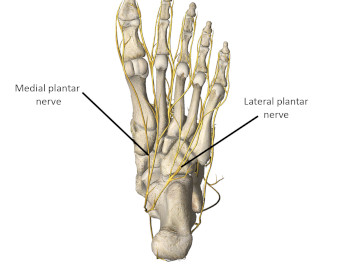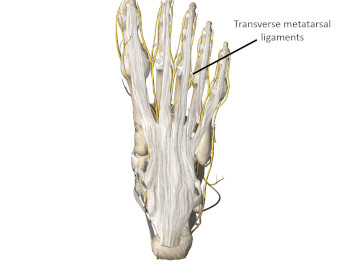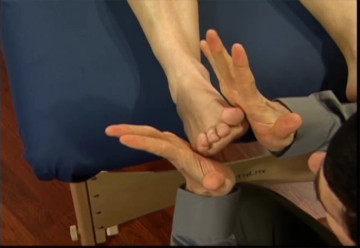Working with Morton’s Neuroma
- Whitney Lowe
Foot pain is a common occurrence in our society. Whether it is standing all day on your job, or giving your feet a serious challenge by running long distances on pavement, the feet certainly can take a beating. Most everyone would agree that it feels great to get your feet massaged, and massage therapy can be an excellent tool for addressing many foot pain complaints. However, there are foot pain conditions that require special consideration and for which some methods of massage are not advised. Morton’s neuroma is a moderately common foot complaint. While some methods of massage are helpful in addressing the complaint, other massage techniques can aggravate the condition and perpetuate the dysfunction.
Characteristics
A neuroma is an inflamed or irritated nerve. Morton’s neuroma is a nerve compression that causes pain in the forefoot and toes. The condition is also called Morton’s metatarsalgia or interdigital neuroma.
Medial and lateral plantar nerves are the primary structures causing pain and dysfunction in Morton’s neuroma. The plantar nerves are an extension of the tibial nerve, which itself is a division of the sciatic nerve. As the tibial nerve passes through the tarsal tunnel on the medial side of the ankle, it divides into the medial and lateral plantar nerves. Both nerves course along the plantar surface of the foot and terminate in the toes. The medial plantar nerve supplies sensory innervation for the the 1st through 3rd digits, while the lateral plantar nerve supplies the 4th and 5th. Morton’s neuroma involves compression of the medial or lateral plantar nerves as they pass between the metatarsal heads (Figure 1).

Figure 1
The medial and lateral plantar nerves on the bottom surface of the foot.
Image is from 3D4Medical’s Essential Anatomy application available on the App Store.
Morton’s neuroma presents with greatest frequency between the 3rd and 4th metatarsal heads because the space between the metatarsal heads is smallest here. The condition can occur between any of the metatarsal heads but is most likely between the 3rd and 4th. The second most common location is between the 2nd and 3rd because the space between them is also relatively narrow.
Morton’s neuroma develops for several reasons. The primary reason is wearing narrow toe-box shoes, which compress the metatarsal heads. Certain anatomical factors also make nerve compression more likely with the narrow toe box shoes. In some people fibers from the medial and lateral plantar nerves converge close to the heads of the 3rd and 4th metatarsals. This junction creates a larger nerve structure between the metatarsal heads making it more vulnerable to compression.
Tensile stress on the nerve during foot motions is also a factor that leads to Morton’s neuroma. The toes are in hyperextension at the very end of the push-off phase during walking or running gait. This extended toe position is also exaggerated by high heel shoes. During toe hyperextension the nerve is pulled taut against the transverse metatarsal ligament, which is deep in the foot and connects adjacent metatarsal heads (Figure 2).

Figure 2
The transverse metatarsal ligaments span between the metatarsal heads
Image is from 3D4Medical’s Essential Anatomy application available on the App Store.
Sometimes a previous injury, such as a fracture or ligament damage, can produce scar tissue that reduces the space between the metatarsal heads. Scar tissue can also bind the nerve to adjacent structures, including the ligament, impairing proper movement of the nerve.
The primary symptoms include sharp, shooting pain, numbness, or paresthesia in the forefoot and extending distally into the toes, typically in the region of the 3rd and 4th toes. Symptoms are aggravated with narrow toe box shoes or those with high heels. There is usually a reduction of symptoms when walking barefoot or wearing shoes with an appropriately wide toe box. Symptoms are also aggravated with shoes that are tied too tight.
There may be pain at the end of the push-off phase when walking or running, and this pain is generally worse when the client is wearing shoes as opposed to being barefoot. Clients may also report a relief of symptoms by massaging the foot, which may spread the metatarsal heads and mobilize the entrapped nerve.
Accurately identifying the complaint
In addition to the signs and symptoms described previously, there are physical examination methods that may help identify the presence of plantar nerve entrapment in the forefoot. During range of motion evaluations pulling the toes in hyperextension and dorsiflexing the foot at the same time may produce symptoms if the condition is advanced.
There is a special orthopedic test called the Morton’s test that is often used to evaluate the likelihood of plantar nerve compression. For this test the client is supine on the treatment table. The practitioner grasps the client’s forefoot from both sides and applies moderate pressure, squeezing the metatarsal heads together (Figure 3). If this action reproduces the client’s symptoms (primarily sharp, shooting pain into the toes, especially the 3rd and 4th), Morton’s neuroma may exist.

Figure 3
The Morton’s test for identifying Morton’s neuroma
Image is from 3D4Medical’s Essential Anatomy application available on the App Store.
Treatment Strategies
The most important factor in treatment of Morton’s neuroma is changing footwear. Sometimes a cushioned dome pad can be worn inside the shoe and this helps spread the metatarsal heads and decrease pressure on the nerve. There are other products like Yoga Toes® and Correct Toes® that can be worn between the toes with certain types of shoes or when the client is barefoot. These toe spacers will help reverse biomechanical patterns that aggravate the nerve compression
Massage can be helpful, but should not be performed with deep pressure between the metatarsal heads. Additional pressure in this region can aggravate the nerve compression and prolong the pathology.
The best results are achieved with massage techniques that encourage spreading and mobilizing the metatarsal heads. Metatarsal spreading is one technique that can help reduce the detrimental effects of nerve compression. To perform this technique pull the metatarsal heads (not just the toes) apart and hold them in this position to help stretch the intrinsic foot muscles and other soft-tissues. When this technique is combined with the use of toe spacers like the ones mentioned above it will be even more effective.
It can also be helpful to perform deep stripping massage techniques along the length of the tibial nerve and the medial and lateral plantar nerves. After properly mobilizing these tissues moving the foot and toes through a full range of motion to make sure the nerve can move freely will also be helpful.
Foot pain like that occurring in Morton’s neuroma can become a debilitating and painful condition. And while massage can be helpful for this condition it is also clear that improperly applied massage can aggravate it and make it worse. Consequently it is crucial that we use good clinical reasoning and appropriate evaluation methods to most effectively help these clients.

